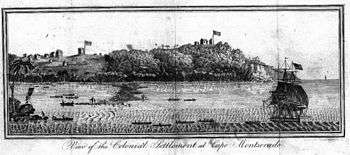Cape Mesurado
Cape Mesurado, also called Cape Montserrado, is a headland on the coast of Liberia near the capital Monrovia and the mouth of the Saint Paul River. It was named Cape Mesurado by Portuguese sailors in the 1560s. It is the promontory on which African American settlers established the city now called Monrovia on 25 April 1822.[1]
_(14591228519).jpg)
There is a lighthouse on Cape Mesurado, located in the Mamba Point neighborhood of Monrovia and in the cape's northwestern portion, that was established in 1855. It is currently inactive, although the Liberian government is seeking financial assistance to restore and reactivate the lighthouse.[2]
History
Slave trading post

Cape Mesurado was being used as a base for the slave trade and in 1815 Governor William Maxwell of Sierra Leone sent an armed force to raid the settlement, seizing ships, merchandise and enslaved Africans from the factories there. The factory owners, Robert Bostock and John McQueen were sentenced to fourteen years transportation to New South Wales by the Vice admiralty court.[3]:1145
A year later the Le Louis was captured by HMS Queen Charlotte of the British West Africa Squadron on suspicion of being engaged in the slave trade.
In 1821, the American Colonization Society dispatched a representative, Dr. Eli Ayers, to purchase land farther north up the coast from Sierra Leone, where the settlers had previously landed at Sherbro Island but were experience a high death rate due to the island's swampy, unhealthy conditions.[4]
Foundation of Liberia
With the aid of Robert F. Stockton, a U.S. naval officer, Ayers sought out land to establish a new colony. Stockton led negotiations with leaders of the Dei and Bassa peoples who lived in the area of Cape Mesurado. At first, the local ruler, Zolu Duma (King Peter), was reluctant to surrender their peoples' land to the strangers, but was forcefully persuaded—some accounts claim at gun-point—to part with a "36 mile long and 3 mile wide" strip of coastal land for trade goods, supplies, weapons, and rum worth approximately $300.[4][5]
The Cape Mesurado colony faced many of the same barriers to success as the previous colony at Sherbro Island: little supplies, as well as swampy and unhealthy conditions. There was also conflict with local tribes, who resented the now Americo-Liberian residents - who had been slaves or the children of former slaves in the United States before their emigration to Africa - trying to put an end to the slave trade.[6] Led by Lott Carey and Elijah Johnson, the Americo-Liberians organized their own defense against local attacks and rejected British military assistance in exchange for hoisting the Union Jack on Cape Mesurado.[6] During the Battle of Fort Hill on 1 December 1822 colonist Matilda Newport is alleged to have repelled an attack by lighting a cannon with an ember from her pipe. The holiday Matilda Newport Day commemorated her action until its abolishment in 1980.[7][8]
Climate
| Cape Mesurado | ||||||||||||||||||||||||||||||||||||||||||||||||||||||||||||
|---|---|---|---|---|---|---|---|---|---|---|---|---|---|---|---|---|---|---|---|---|---|---|---|---|---|---|---|---|---|---|---|---|---|---|---|---|---|---|---|---|---|---|---|---|---|---|---|---|---|---|---|---|---|---|---|---|---|---|---|---|
| Climate chart (explanation) | ||||||||||||||||||||||||||||||||||||||||||||||||||||||||||||
| ||||||||||||||||||||||||||||||||||||||||||||||||||||||||||||
| ||||||||||||||||||||||||||||||||||||||||||||||||||||||||||||
References
- History Of Liberia: A Timeline
- Rowlett, Russ. "Lighthouses of Liberia". The Lighthouse Directory. University of North Carolina at Chapel Hill.
- Helfman, Tara (2006). "The Court of Vice Admiralty at Sierra Leone and the Abolition of the West African Slave Trade". Yale Law Journal. 115 (5): 1122–1156. Retrieved 27 February 2016.
- The United States And Africa
- The Roots Of African-American Identity
- Sheldon, Kathleen (2005). "Newport, Matilda (c. 1795–1837)". Historical Dictionary of Women in Sub-Saharan Africa. Scarecrow Press. pp. 171–172. ISBN 978-0-8108-6547-1.
- Steady, Filomena Chioma (2012). "Women and Leadership in Liberia". Women and Leadership in West Africa: Mothering the Nation and Humanizing the State. Palgrave Macmillan. p. 109. ISBN 978-1-137-01038-4.
- "NASA Earth Observations Data Set Index". NASA. Retrieved 30 January 2016.